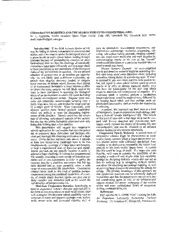
Cooperative Robotics and the Search for Extraterrestrial Life PDF
Preview Cooperative Robotics and the Search for Extraterrestrial Life
COOPERATIVE ROBOTICS AND THE SEARCH FOR EXTRATERRESTRIAL LIFE. M. L. Lupisella, NASA Goddard Space Flight Center, Code 584, Greenbelt Rd, Greenbelt MD, 20771 [email protected] Introduction: If we think tenuous abodes of life such as metabolism measurement experiments, epi- may be hiding in remote extraterrestrial environmental flourescence microscopy, molecular sequencing, cul- niches, and if we want to assess the biological status of turing, sub-surface boring payloads, imaging capabili- a given locale or entire planet before sending humans ties, etc. could cover much area and work together by (perhaps because of contamination concerns or other communicating results to the rest of the "swarm" motivations) then we face the challenge of robotically which could then focus on a particular location where a exploring a large space efficiently and in enough detail positive result was found. to have confidence in our assessment of the biological Mission Scenario Example: An over-simplified status of the environment in question. On our present search and detection scenario might be something like: schedule of perhaps two or so missions per opportu- first send many small water detection robots, including nity, we will likely need a different exploratory ap- subsurface boring moles, to a promising area. If water proach than singular stationary landers or singular is detected by any one robot, confirm with another ro- rover missions or sample return, because there appear bot, and signal to other robots (which could be stored to be fundamental limitations in these mission profiles nearby or in orbit, or already deployed nearby, etc.) to.obtain the many samples we will likely need if we that have the functionality for the next step which want to have confidence in assessing the biological might be detection and measurement of organics. If a status of an environment in which life could be hiding promising result is reported, perhaps a metabolism in remote environmental niches. Singular rover mis- based experiment would be required next, followed by sions can potentially accommodate sampling over a an imaging based robot, and then perhaps more so- fairly large area, but are still limited by range and can phisticated functionality such as molecular sequencing be a single point of failure. More importantly, such or culturing. mission profiles have limited payload capabilities In general, this approach can been seen as a kind which are unlikely to meet the demanding require- of biologically inspired exploration methodology, per- ments of life-detection. Sample return has the advan- haps a form of "swarm intelligence" [2]. The benefit tage of allowing sophisticated analysis of the sample, of this kind of approach is that large areas can be cov- but also has the severe limitations associated with only ered with diverse detection and experimental tech- being able to bring back afew samples. niques which increase the chance of detecting life, and This presentation will suggest two cooperative comprehensive data can be obtained in an efficient robotic approaches for exploration that have the poten- manner during just one mission opportunity. tial to overcome these difficulties and facilitate effi- Cooperative Family Robotics: A second form of cient and thorough life-detecting exploration of a large cooperative robotics might be characterized as coop- space. Given the two premises state above, it appears erativefamily robotics where a larger parent rover car- at least two fundamental challenges have to be met ries smaller rovers with additional specialized func- simultaneously: coverage of alarge space and bringing tionality to be deployed as required by the higher level to bear a sophisticated suite of detection and experi- analysis of the more mobile larger rover. A system mental payloads on any specific location in order to like this could be large or small. If a larger size were address amajor challenge in looking for extraterrestrial feasible, we'd want to consider the possibility of de- life: namely, executing a wide variety of detection sce- veloping a walk-roll and maybe even hop capability narios and in situ experiments in order to gather the perhaps by designing Iockable wheels that can act as required data for a confident assessment that life has feet for walking (e.g. to navigating difficult terrain) been detected and to, more generally, cover a wide and allow for crouching and perhaps hopping, as well range of extraterrestrial life possibilities. Cooperative as covering large distances by unlocking the wheels for robotics lends itself to this kind of problem because roiling. The primary advantages of this approach are cooperation among the combined capabilities of avari- that specialized functions can be selectively deployed ety of simple single function agents can give rise to in real-time and that the parent rover can act as a cen- fairly complex task execution such as the search for tral coordinating agent as well as an infrastructural and detection of extraterrestrial life. support element for power recharging of the smaller Shot-Gun Cooperative Robotics: Specifically, a rovers and more sophisticated forms of navigation, kind of cooperative robotics shot-gun approach [1] in drilling, communication, etc. the form of tens to hundreds or more small robots, each References: with a singular life-detection related capability such as [i] Lupisella M. L. (1998) "Life" Looking for Life, detection of water and organics (perhaps even nucleic Jet Propulsion Laboratory Biomorphic Explorer acids, amino acids and associated chirality, etc.) or Workshop. [2] Bonabeau E., Dorigo M., Theraulaz G. SHORT TITLE HERE: A.B. Author and C,D. Author (1999) Swarm intelligence: from natural to artificial systems. New York: Oxford University Press.
